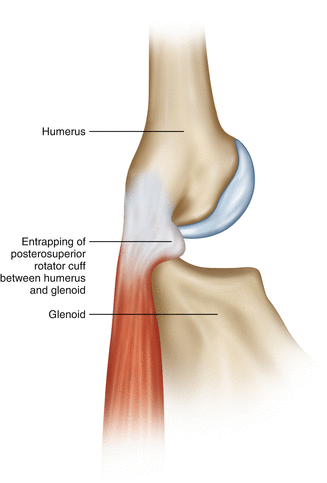Fig. 5.1
Arthroscopic images of a posterosuperior labral tear (a) and an undersurface partial-thickness rotator cuff tear of posterior supraspinatus before (b) and after (c) arthroscopic debridement in an overhead athlete with internal impingement (Courtesy of Brian Wolf, MD)
Walch et al. originally described impingement of the deep surface of the posterior supraspinatus and the anterior infraspinatus on the posterosuperior glenoid in 17 patients undergoing shoulder arthroscopy [24] (Fig. 5.2). Findings of the arthroscopy included articular surface cuff tears and posterior labral tears without any other intraarticular pathology. Walch hypothesized that this phenomena occurs in all shoulders in the abducted, externally rotated position but may become pathologic in throwers because of the repetitive insult. Jobe theorized that anterior capsular laxity was the main factor in the development of internal impingement, therefore recommending anterior capsular plication as a treatment [25]. Current data actually supports the opposite premise that anterior laxity with anterior glenohumeral subluxation likely lessens internal impingement instead of aggravating it [26].


Fig. 5.2
Internal impingement of the posterior rotator cuff between the humerus and glenoid during maximal abduction and external rotation
Most recently, Burkhart et al. has proposed that posterior capsular contracture and a loss of internal rotation are the main factors in the development of internal impingement [27]. Burkhart et al. hypothesized that the posterior capsule becomes injured and thickened due to repetitive tensile forces created during the deceleration phase of throwing [27]. This posterior capsule contraction leads to shifting the center of rotation of the shoulder more posteriorly and superiorly leading to posterosuperior instability with the shoulder abducted and externally rotated. The posterosuperior shift allows humeral hyperexternal rotation which places shear stress on the posterosuperior labral and torsional stress on the posterior cuff leading to undersurface posterior supraspinatus and infraspinatus tear as well as superior labral tears [27] (Fig. 5.3). With a posterosuperior shift of the glenohumeral center of rotation, the space-occupying effect of the proximal humerus on the anteroinferior capsule and ligaments is reduced, leading to redundancy. Prior theories supporting anterior instability as the source of internal impingement were likely a misinterpretation of the redundancy of the anterior inferior glenohumeral ligaments as microinstability. Treatment of pathologic internal impingement concentrates on posterior capsular stretching to reduce the internal rotation deficit as well as strengthening of the posterior cuff to aid in resisting the distracting forces during deceleration and follow-through phases.


Fig. 5.3
The shift in position of the glenohumeral joint center of rotation (depicted by the arrow) in a posterior and superior direction is initiated by contracture of the posteroinferior capsule leading to redundancy of the anteroinferior capsule and ligaments resulting in increased sheer forces at the biceps anchor and superior labrum resulting in a superior labral tear
References
1.
Chakravarty K, Webley M. Shoulder joint movement and its relationship to disability in the elderly. J Rheumatol. 1993;20:1359–61.PubMed
2.
Milgrom C, Schaffler M, Gilbert S, van Holsbeeck M. Rotator-cuff changes in asymptomatic adults. The effect of age, hand dominance and gender. J Bone Joint Surg Br. 1995;77(2):296–8.PubMed
3.
Sher JS, Uribe JW, Posada A, Murphy BJ, Zlatkin MB. Abnormal findings on magnetic resonance images of asymptomatic shoulders. J Bone Joint Surg Am. 1995;77:10–5.PubMed
4.
5.
Tashjian RZ, Farnham JM, Albright FS, Teerlink CC, Cannon-Albright LA. Evidence for an inherited predisposition contributing to the risk for rotator cuff disease. J Bone Joint Surg Am. 2009;91(5):1136–42.CrossRefPubMedCentralPubMed
Stay updated, free articles. Join our Telegram channel

Full access? Get Clinical Tree








